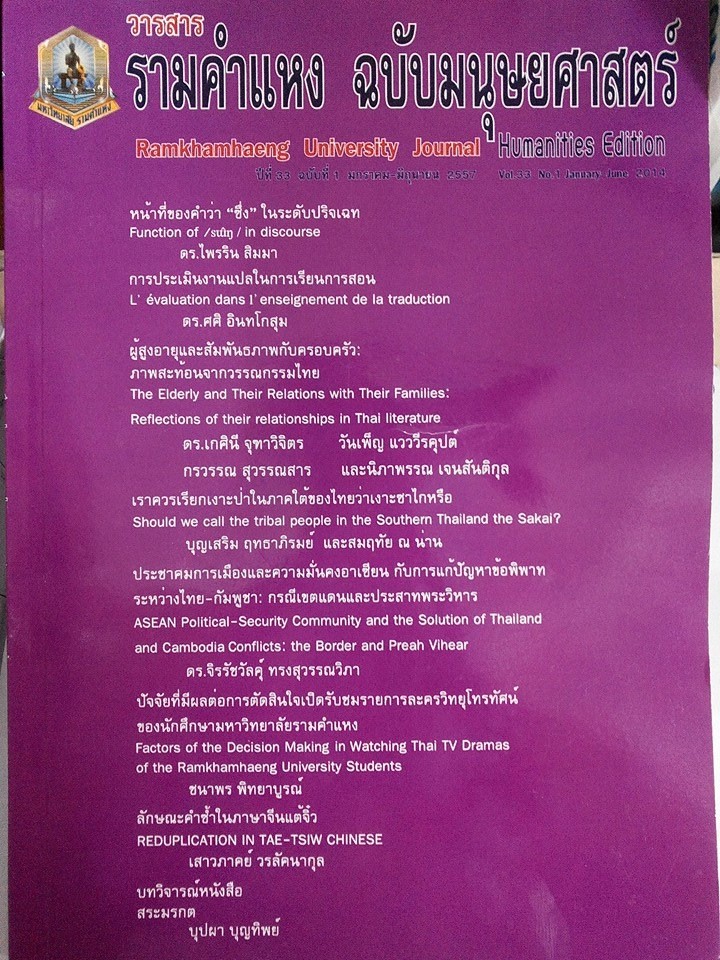ลักษณะคำซ้ำในภาษาจีนแต้จิ๋ว REDUPLICATION IN TAE-TSIW CHINESE
Main Article Content
บทคัดย่อ
บทคัดย่อ
งานวิจัยนี้มุ่งศึกษาลักษณะคำซ้ำภาษาจีนแต้จิ๋วที่พูดอยู่ในกรุงเทพมหานคร ซึ่งผู้วิจัยได้รวบรวมข้อมูลจากผู้ให้ข้อมูลชาวจีนแต้จิ๋วที่เป็นเจ้าของภาษามีอายุระหว่าง 54-70 ปี และอาศัยอยู่ในกรุงเทพมหานครไม่น้อยกว่า 20 ปี เนื้อหาของงานวิจัยนี้ประกอบด้วยลักษณะโครงสร้างภาษาจีนแต้จิ๋ว ประเภทของคำซ้ำ คำซ้ำกับเสียงวรรณยุกต์ และคำซ้ำกับความหมายของภาษาจีนแต้จิ๋ว
ผลการวิจัยพบว่า ลักษณะคำซ้ำในภาษาจีนแต้จิ๋วเป็นการซ้ำคำและซ้ำพยางค์ ซึ่งแบ่งตามจำนวนพยางค์ได้ 3 ลักษณะ ได้แก่ (1) คำซ้ำประเภทสองพยางค์ (2) คำซ้ำประเภทสามพยางค์ (3) คำซ้ำประเภทสี่พยางค์ ส่วนลักษณะการซ้ำคำมีสองลักษณะคือ (1) คำซ้ำที่ติดต่อกัน มีอยู่ 7 รูปแบบ (2) คำซ้ำที่ไม่ติดต่อกัน มีอยู่ 5 รูปแบบ และคำซ้ำแต่ละรูปแบบมีพื้นฐานมาจากคำซ้ำสองพยางค์ทั้งสิ้น สำหรับคำซ้ำกับเสียงวรรณยุกต์ ลักษณะการซ้ำคำแต่ละรูปแบบ เสียงวรรณยุกต์ของคำเดิมจะเปลี่ยนไปจากคำเดิมยกเว้นคำที่มีเสียงวรรณยุกต์ที่หนึ่ง ส่วนคำซ้ำกับความหมายของคำซ้ำนั้นอาจเปลี่ยนไปจากความหมายเดิมหรือความหมายใหม่ขึ้นอยู่กับเสียงวรรณยุกต์ ชนิดของคำ และตำแหน่งของคำซ้ำในวลีหรือประโยคนั้น ๆ
ABSTRACT
This is a study of reduplication in Tae-Tsiw Chinese spoken in Bangkok. The data were collected from the native Tae-Tsiw Chinese speakers aged between 54-70 years who have been living in Bangkok for 20 years. The study consists of the structures and types of Tae-Tsiw Chinese reduplication, the reduplication and tones, as well as the reduplication and their meanings.
The findings of the study found that the reduplication in Tae-Tsiw Chinese may be either word reduplication or syllabic reduplication according to the number of syllables, the reduplication can be devided into 3 types: two syllabic reduplicatives, three syllabic reduplicatives and four syllabic reduplicatives. While the patterns of reduplicative consist of both the continuous reduplicative words and The discontinuous reduplicative words. The first one has seven patterns and the second has five respectively, and each pattern is based on the two reduplicative words. The tones of reduplication may be changed from the original tones except the mid-level tone. The meanings of the new reduplicative words may be changed from the original meaning or the new meaning depending upon the tones, and grammatical categories as well as the position of reduplication of phrases or sentences.
Article Details

อนุญาตภายใต้เงื่อนไข Creative Commons Attribution-NonCommercial-NoDerivatives 4.0 International License.
ประกาศลิขสิทธิ์จะปรากฏในเกี่ยวกับวารสาร ควรอธิบายสำหรับผู้อ่านและผู้เขียนว่าเจ้าของลิขสิทธิ์เป็นผู้เขียนวารสารหรือบุคคลที่สาม ควรรวมถึงข้อตกลงการอนุญาตเพิ่มเติม (เช่นใบอนุญาตครีเอทีฟคอมมอนส์) ที่ให้สิทธิ์แก่ผู้อ่าน (ดูตัวอย่าง) และควรให้วิธีการรักษาความปลอดภัยหากจำเป็นสำหรับการใช้เนื้อหาของวารสาร


